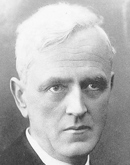

Ivan Vurnik
*1. 6. 1884 – Radovljica, Slovenia
†8. 4. 1971 – Radovljica, Slovenia
Biography
Ivan Vurnik was born on June 1, 1884, in Radovljica in northern Slovenia to a wealthy stonemason family, which allowed him to attend the Technical University of Vienna after studying in Kranj and Ljubljana. He graduated in 1912 under Prof. Karl Mayreder. For his good academic results, he received a several-month travel scholarship to Italy. After returning, he received an offer to work for the Viennese architect Ludwig Baumann. At the same time, he worked on his own projects in Slovenia. Vurnik was primarily influenced by the Art Nouveau work of his teacher, Prof. Maks Fabiani, from the Vienna Technical University. In the autumn of 1913, he married the Viennese Impressionist painter Helena Kotter. In 1919, the couple moved back to Ljubljana, where Vurnik sought to establish and specify the Slovenian national style, combining elements of aesthetics and ornamentalism. Traditional rural motifs and partly Art Nouveau elements were to help with this. One of the main buildings of the so-called 'National Style' was the colorful Cooperative Bank building from 1922. The later construction of the Sokol sports association from 1926 already contained simpler and more archaic elements. Similar projects were also realized in Golnik and others in Kranj, but they were destroyed during World War II. By the late 1920s, Vurnik abandoned the ideas of the national style and turned to the pure forms of functionalist architecture. In 1919, Vurnik was instrumental in founding the Institute of Architecture at the Faculty of Technology at the University of Ljubljana. By the end of the 1920s, he managed to convince Jože Plečnik to start teaching here as a professor. However, a rivalry arose between the two. He believed that Plečnik influenced circles of conservative politicians to prevent the realization of his functionalist projects. Another reason for the hostility between the two architects possibly stemmed from their differing political beliefs. While Plečnik was rather conservative and a devout Roman Catholic, Vurnik, despite his confession, was also a progressive national liberal. After 1925, he mainly focused on teaching. Until the end of his life, he was involved in architectural and urban planning activities, but his projects remained only on paper. Among the few realized projects is the functionalist swimming pool and hotel in Radovljica. A lesser-known, but still important project is his workers' houses in Maribor, where Vurnik presented a vision of a simple and utilitarian way of life. In 1965, he was offered by the Catholic Church to renovate the Church of St. Vid in Brezje. In his modifications of the largest Slovenian pilgrimage church, significant for its relics, he had to take into account the designs of his former associate Jože Plečnik from the 1930s. Vurnik, who designed the colored mosaic and thus gave the altar a more distinguished position (in 2008, Maruša Zorec continued this), returned in this peak work back to the 'national style' which he had originally rejected in the 1920s. Ivan Vurnik, together with Maks Fabiani and Jože Plečnik, is regarded as one of the fathers of modern Slovenian architecture.The English translation is powered by AI tool. Switch to Czech to view the original text source.












